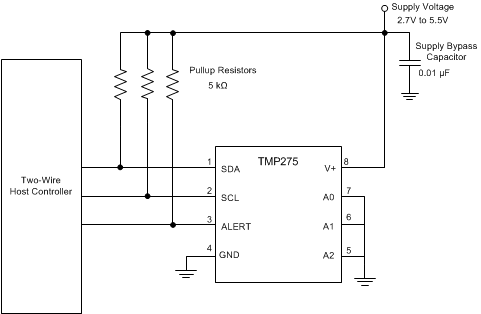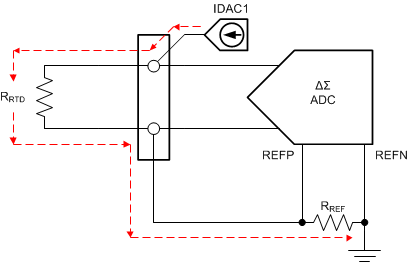SNAA422 October 2024 ADS1015 , ADS1115 , ADS112C04 , HDC3020 , INA180 , INA241B , INA280 , TMP275
Overview
As server hardware continues to push the boundaries of computing performance, the demands for efficient thermal management increase. Liquid cooling is increasing in popularity in data centers due to its ability to dissipate heat more effectively than traditional air cooling. However, liquid cooling systems introduce the risk of fluid leaks, which can harm the operation and reliability of server components, especially server cards. This application brief primarily focuses on leak detection techniques, flow monitoring, and pressure sensing.
Importance of Leak Detection in Liquid-Cooled Systems
Liquid cooling methods can significantly reduce the temperature of server cards and increase overall system performance due to liquid having a high heat dissipation factor compared to traditional air-cooled systems. However, any leakage within these systems poses a threat to both the hardware and data integrity. Undetected leaks can lead to short circuits and electrical failures, corrosion of server components, downtime and data loss, and expensive repair and replacement costs.
Implementing leak detection mechanisms with precision analog-to-digital converters (ADCs) is essential to mitigate leakage risks and maintain high reliability and uptime of the server infrastructure.
Leak Detection Techniques for Liquid Cooled Servers
Several leak detection techniques can be employed to identify fluid leaks in server cards and the Coolant Distribution Units (CDU).
Resistive-Based Leak Sensors
Resistive-based leak sensors are widely used in data centers. These sensors operate by detecting the presence of a conductive liquid on the surface of the sensor. When a leak occurs, and the cooling fluid comes into contact with the sensor, the sensor's resistance changes, and an ADC such as the ADS1015 detects the change in resistance, which may trigger an alarm or maintenance inquiry. There are some key points to consider, such as the placement of the leak sensors, which should be strategically placed around server cards and at potential leak points, such as fluid connectors and tubing joints. Correct placement helps validate that the smallest leaks are found early to prevent future issues. The sensitivity level of the sensor is essential to detect very small amounts of liquid while minimizing false alarms caused by condensation.
Precision ADC devices like the ADS1015 and ADS1115 enable unique sensor placement because of easy to use designs and the small size. These devices are flexible enough to take in various signal levels depending on the sensitivity of the leak sensor.
Figure 1 shows an example circuit of how a leak sensor is modeled. The leak sensor is shown as a variable resistor because when liquid leakage is detected, the sensor's resistance changes accordingly.
 Figure 1 Variable Leak Sensor.
Figure 1 Variable Leak Sensor. Humidity and Temperature Sensors
A rise in humidity or a sudden change in temperature near a server card can indicate a potential leak. Humidity sensors detect an increase in moisture levels, which may suggest the presence of evaporating coolant, potentially indicating a leak in the system; a device such as the HDC3020 accurately monitors humidity, establishing that it remains in a safe range. Similarly, a possible leak can cause a significant rise in temperature as the coolant escapes, leading to localized temperature sensing on the server boards and CDU with a device such as the TMP275. These sensors serve as an early alert to warn the system about leaks or other issues before physical damage occurs to the server racks. This method of humidity and temperature sensing is best used in conjunction with other leak detection methods, such as resistivity-based monitoring, for a comprehensive monitoring plan.
Figure 2 shows an example of correctly using the TMP275 in a system to monitoring temperature.
 Figure 2 TMP275 for Temperature Monitoring
Figure 2 TMP275 for Temperature MonitoringSometimes there is a need for highly accurate temperature measurements to control the cooling system precisely and maximize the efficiency of the CDU; use a thermistor for accurate measurements, and TI offers a family of thermistors here. Resistance Temperature Detectors (RTDs) are another way to measure such temperatures accurately; the PT100 is a very popular RTD and enables precise temperature measurements. When using RTDs to measure temperature, ADCs with integrated digital-to-analog (iDACs) are typically used as a current source to excite the RTD, which establishes a reference voltage for the ADC as in Figure 3. This method of temperature sensing significantly reduces the error in the temperature measurement. Using devices like the ADS112C04 enables very precise measurements with RTDs for CDUs.
To learn about designing with ADCs for RTD measurements, see A Basic Guide to RTD Measurements.
 Figure 3 Delta-Sigma ADC for RTD Measurements
Figure 3 Delta-Sigma ADC for RTD MeasurementsPressure Monitoring
All liquid cooling systems, from automobiles to servers, operate within a specific fluid pressure range to establish maximum efficiency and safety. A sudden change in system pressure typically indicates that a problem has occurred, such as a leak, blockage, or high-temperature event in the cooling circuit. Integrating pressure sensors into the fluid lines or the CDU makes it possible to detect fluid pressure changes in real-time. These sensors are typically linked to automated control systems that shut down fluid flow to the affected areas upon leak detection to minimize any damages caused by liquid leakage. Using devices like the ADS112C04 and ADS1015 enable precise measurements of analog pressure transducers or a Wheatstone bridge circuits - shown in Figure 4.
To learn about designing with ADCs for Bridge Measurements, see A Basic Guide to Bridge Measurements.
 Figure 4 ADC Interfacing with a Pressure Sensor Shown as a Wheatstone Bridge.
Figure 4 ADC Interfacing with a Pressure Sensor Shown as a Wheatstone Bridge. Flow Monitoring
Liquid flow monitoring in the CDU is critical because the components and hardware can quickly become overheated and damaged without a consistent cool liquid flow. Flow monitors help to verify that cooling systems are operating efficiently, saving energy costs and extending the life of the equipment. Monitoring flow can also help to identify leaks, failing pumps, and other issues. A sudden drop in flow rate can indicate a leak or pump failure; neither event is good for a liquid-cooled server. Typically, the type of flow meters that are used are analog output. Therefore, they must be monitored with an ADC such as the ADS112C04, ADS1015, or ADS1115, which enables precise measurements, verifying that flow is accurately monitored and reported back to the system controller.
Other Areas of Sensing
In several other areas, sensor measurements occur in the server racks or the CDU, such as the coolant reservoir fluid level, fluid composition, or pump monitoring. These are a few additional parameters that can sensed in a liquid cooling system, to validate that the system is operating within specifications. By monitoring these parameters, maintenance and repairs are scheduled according to information provided from the system. With the additional monitoring, there is reduced downtime, system failures, and energy consumption since the system operates within the design limits, which mean a efficient usage of power, and reduced operational stress on the system. A device such as the ADS1015 is typically sufficient for these other monitoring applications within 0 to 5V. Current sense amplifiers such as the INA180, INA280, or INA241B can monitor the DC-link current of the pump motor for added monitoring and protection, as shown in Figure 5.
 Figure 5 Current Sensing Circuit.
Figure 5 Current Sensing Circuit. Conclusion
Effective leak detection and sensor monitoring in liquid-cooled server cards is crucial to maintaining the performance and reliability of server systems. Using sensors, real-time monitoring, and preventive measures, data centers can significantly reduce the risks associated with coolant leaks. Enabling leak, flow, pressure, and other types of sensing allows for automated control and notifications that are directly sent to technicians on-site to resolve issues quickly and reduce server downtime. Adopting a multifaceted approach to monitoring enhances protection against hardware failure and establishes efficient and cost-effective data center operations.